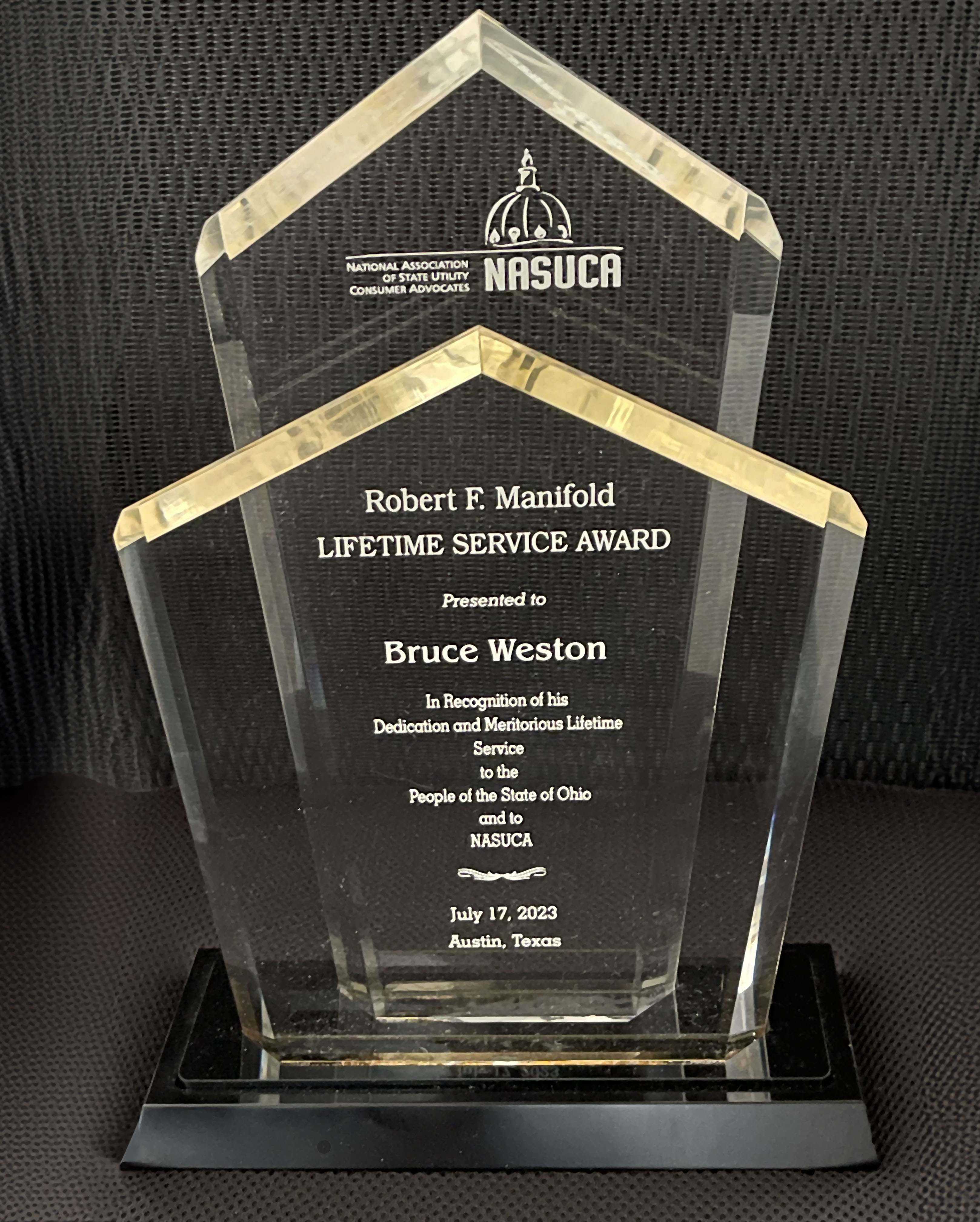Before
The Ohio House of Representatives
Public Utilities Committee
Testimony on House Bill 128
(Partial Repeal of Nuclear Bailout in House Bill 6)
Jeff Jacobson, Strategic Insight Group
On Behalf of the Office of the Ohio Consumers’ Counsel
March 2, 2021
Hello Chair Hoops, Vice-Chair Ray, Ranking Member Smith, and Committee members. I hope you and your colleagues are well.
Consumers’ Counsel Weston and I thank you for this opportunity to testify as an interested party on House Bill 128. The bill is for a partial repeal of House Bill 6. I am testifying on behalf of the Office of the Ohio Consumers’ Counsel, for Ohio residential utility consumers. OCC testified seven times against tainted House Bill 6. And we’ve now testified eight times to repeal it. Attached is OCC’s Subsidy Scorecard that shows the costly subsidies (for consumers) of the government’s intrusion into the electric market since Ohio deregulation in 1999.
On the general process of tainted House Bill 6, Governor DeWine commented that it “stinks.”1 A news outlet wrote about HB6 under the headline “Ohio just passed the worst energy bill of the 21st century.”2
U.S. Attorney David DeVillers described the scandal as "likely the largest bribery and money-laundering scheme ever in the state of Ohio.”3
Standard and Poor’s assessed FirstEnergy this way, in connection with the scandal:
We believe these violations at the highest level of the company are demonstrative of insufficient internal controls and a cultural weakness. We view the severity of these violations as significantly outside of industry norms and, in our view, they represent a material deficiency in the company's governance.4
Just last Friday the Fitch Ratings service published an outlook on OVEC and its coal plants that HB6 subsidizes, which included a dour projection (from a consumer perspective). Fitch Ratings expects that the AEP, DP&L and Duke coal plant losses will continue: “Nonetheless, Fitch expects OVEC's all-in costs [sic] exceed prevailing merchant power prices and the plants to remain uneconomical for the foreseeable future.”5 But investors who read Fitch had good news, in its reporting that Ohio government solved their coal-plant problem at consumer expense: “The three PUCO regulated utilities ... recover OVEC costs through the legislatively mandated non-bypassable rate mechanism through 2030.”6
There has been fallout in the scandal’s aftermath. The leader of the Ohio House of Representatives (Speaker), FirstEnergy (CEO) and the PUCO (Chair), respectively, are out. Some others have pleaded guilty to crimes. And it’s not known what else may be revealed about the scandal.
Other casualties from HB6 include, according to reports, that at least two natural gas power plants were canceled due to subsidizing of competitors in HB6. That means Ohio lost a couple billion dollars in investment.
Thus, for a variety of reasons, it is good that HB128 would repeal the nuclear bailout earlier sought by FirstEnergy/Energy Harbor. These reasons for repeal include the protection of Ohio consumers and the competitive power plant market that serves consumers through lower prices and greater innovation. I will have some further points to make on the nuclear bailout, near the end of this testimony.
Also, we appreciate that HB128 would repeal the FirstEnergy recession-proofing (as its fired CEO described HB6 decoupling). Further, this bill would rightly repeal the FirstEnergy profits benefit that, at consumer expense, was slipped into the 2019 state budget bill (HB166).
But a big thing missing from HB128 is a repeal of the HB6 bailout that AEP, DP&L and Duke managed to obtain for their outmoded, uneconomic, and polluting coal power plants (the two OVEC plants). The HB6 money-counter on OCC’s website home page (www.occ.ohio.gov) shows that the HB6 coal subsidy has cost Ohioans about $100 million to date. And, to add insult to injury, Ohio’s HB6 coal subsidy is aiding the pollution of the planet. That subsidy for coal power plants may rate as even worse than the nuclear bailout, given its double whammy of increasing consumers’ electric bills and pollution. The coal subsidy should be repealed. And the PUCO should be prohibited from reinstating the coal plant subsidy. Let the market work.
It is too bad for consumers that utility and coal special interests were able to circumvent the Ohio deregulation statute that would have prevented such power plant subsidies. O.R.C. 4928.38 required that, after the transition to electric deregulation, “the utility shall be fully on its own in the competitive market.”
The HB6 coal subsidy not only benefits utility special interests. It also contains a less known benefit for big industrial special interests. The big industrials are paying less now under the HB6 subsidy (with its cap on the monthly charge) than they paid under the prior PUCO subsidy.
Additionally, a refund requirement should be enacted, to return to consumers the coal subsidies they were charged under HB6. OCC appreciates that HB128 gives refunds to consumers for the decoupling charges collected under HB6 and any FirstEnergy profits charges related to HB166. This is a needed protection given the sorry history of the lack of refunds for Ohio utility consumers. Attached is an OCC pie chart showing $1.5 billion in refunds denied to electric consumers since the 2008 energy law, after the Supreme Court invalidated various charges.
Moreover, there is an unfortunate provision in House Bill 6, Section 5 (O.R.C. 4928.75), that can divert some federal financial assistance away from consumers who desperately need money now. It involves the federal Home Energy Assistance Program (HEAP) funds. House Bill 6 requires the Ohio Development Services Agency to annually seek a waiver from the federal government. This process would allow diverting some HEAP funds away from consumers for bill-payment assistance, toward subsidizing low-income weatherization (such as for landlords). What many struggling Ohioans need now in the pandemic and in the years of its aftermath is financial assistance and plenty of it, not weatherization. HB128 should have Ohio lead with its heart to repeal this provision of HB6.
It is good to see that HB128 will take a step toward addressing the rising cost of transmission projects (including supplemental projects) that are increasing consumers’ electric bills. But the bill is too small of a step for a problem that is already too large for consumers.
As background, PJM defines a Supplemental Transmission Project as a transmission expansion or enhancement that is not required for compliance with, among other things, system reliability or operational performance, and is not determined to be a state public policy project. Supplemental projects are not formally approved by the PJM Board. At the state level, the Ohio Power Sighting Board (OPSB) has a threshold of 100kV for oversight of projects. Because the voltage level of many of these transmission line projects is below 100kV, the projects are not reviewed for prudency, need or cost by the Ohio Power Siting Board. These projects are essentially unreviewed, even though ultimately utility monopolies are charging their captive customers for the projects. This 100kV threshold needs to be reduced so the State can review the need and cost effectiveness of these transmission projects. There needs to be more scrutiny for all transmission projects that are charged to Ohio customers and thus there should be a lower kV threshold for OPSB review and approval.
So HB128 is actually too small of a step toward consumer protection. The bill should be amended to increase consumer protections now for supplemental projects. Those protections should start with requiring more review and state authority (by lowering the kV threshold) to protect consumers, by enabling denial of inappropriate transmission charges.
As a final matter, it is said that Energy Harbor apparently wants its billion-dollar nuclear power plant subsidy repealed.7 Respectfully, the Ohio public (and this Committee) should hear directly from Energy Harbor on this subject, under oath, in the light of day. And, respectfully, the public should have the benefit of a legislative investigation into House Bill 6. That investigation should include answers about whether the legislature and the public were misled by FirstEnergy, Energy Harbor, and others. Specifically, that scrutiny should include whether the Davis-Besse and Perry nuclear plants really needed the HB6 subsidy and whether they would have closed in the absence of the subsidy. Recall news reports like this one, “How (un)profitable are Ohio’s two nuclear plants? FirstEnergy Solutions says it can’t tell the public.”8
Thank you for your consideration.
1 “FirstEnergy denies wrongdoing as DeWine calls for repeal and replace of nuke plant bailout,” Cincinnati
Enquirer (July 23, 2020).
2 “Ohio just passed the worst energy bill of the 21st century,” D. Roberts, Vox (July 27, 2019).
3 “U.S. attorney departs, but HB 6 investigation is far from over,” M. Schladen, Ohio Capital Journal
(March 1, 2021).
4 “S&P downgrades FirstEnergy following $1.95B draw on revolving credit facility,” U. Khalid, S&P Global
Market Intelligence, (November 25, 2020).
5 “Fitch Affirms Ohio Valley Electric Corp. at 'BBB-'; Outlook Stable,” Fitch Ratings (February 26, 2021).
6 Id.
7 “Never needed? Senate president predicts little opposition to nuclear bailout repeal,” M. Schladen, Ohio
Capital Journal (February 18, 2021).
8 “How (un)profitable are Ohio’s two nuclear plants? FirstEnergy Solutions says it can’t tell the public,” J.
Pelzer, Cleveland Plain Dealer (June 24, 2019).

